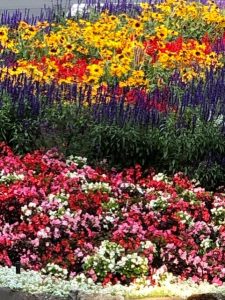In September, I took an extended trip through the Pacific Northwest to explore famous gardens. First stop, the Washington Park International Rose Test Garden and the Japanese Garden in Portland. Then, even though not a botanical or destination garden, I was impressed by the waterfall garden at the entrance to REI’s “mother ship” in Seattle.
On to Vancouver, British Columbia, to the Ecological Society gardens in Stanley Park and a naturalist-led tour of a native Pacific rainforest. Botanical gardens—samplings of plants from around the world—were located at the University of British Columbia and the Van Dusen Garden in Vancouver.
West Coast horticultural design and landscaping techniques were demonstrated at Abkhazi Garden and the Horticulture Centre of the Pacific in Victoria. The Butchart Gardens were an opulent, impressive rehabilitation of a former quarry. My personal favorite was a Saturday morning spent touring three private gardens in the James Bay area of Victoria, not far from Beacon Hill Park.
The gardens were riotous with flowers, many curated to provide color-coordinated displays. Ample water grew huge Douglas firs and massive giant sequoias. I was smitten!
When I expressed to one docent my “inspiration” to go home and transform my own garden, he cautioned, “Remember, these gardens have hundreds of volunteers and lots of paid staff to maintain them.” So, rather than undertake an entire garden transformation, here are three lessons I took away from the great gardens of the Pacific Northwest:
Pruning is an art form: Various Japanese gardens demonstrated exquisite pruning techniques. Japanese maples and junipers formed ground-hugging mats. Shrubs and small trees, shaped by judicious pruning, concealed or revealed a view, or formed a hedge or screen. In private gardens, espaliered apple trees produced fruit on small, well-pruned plants.
Always carry your pruners: A corollary to the above lesson, pruning is much less daunting when done perpetually. One garden docent told the story that—during the COVID-19 pandemic when the garden was closed to the public—paid staff was reduced to one man who went out every day with his pruners. His consistent pruning maintained the garden in good shape for its eventual reopening.
Along my side fence is a rambler rose that grows prolifically (even in the absence of any summer water) and routinely attacks me. Keeping my pruners handy, it’s easy to control those wayward canes and now I walk through my garden uninjured!
“Place” is everything: Master Gardeners often talk about gardening with a sense of place using plants that are adapted to the area. One gorgeous gray-green plant topped by salmon-colored, tubular flowers was massed everywhere. People asked “What is that plant?” The answer: California fuchsia, Epilobium canum. It was gorgeous!
On the way home, in a campground in the Sacramento Valley, protected from deer by wire cages, were California fuchsias. Looking nothing like their cousins in Victoria, these were tiny, stunted plants struggling to exist after a 114-degree heat wave. The moral? Don’t be discouraged that your garden isn’t like the lush, well-watered, professionally tended, gorgeous displays located in areas with ample moisture and moderate temperatures year-round. Provide consistent care to the garden you have and enjoy its blooms.
Rebecca Miller-Cripps is a University of California Cooperative Extension Master Gardener of Tuolumne County who traveled in September and pruned in October.


